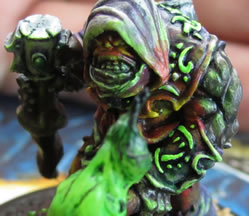We're all (hopefully) used to painting miniatures with some kind of light source in mind. Typically, you're using Zenithal Lighting - a generic light shining down on your figure from above. Most of the time, this will be a "white" light source as when you highlight, it's with colours that only lighten your painted area.
What I'm looking at in this article are cases where something on your model is creating an additional light and how it affects your painting. This is called Object Source Lighting, often abbreviated as "OSL".
Colour of Light Source vs Glow
 |
| source |
The torch this model is carrying was painted with white, yellow, green and a little black for smoke. But the glow it creates is only painted using green.
The glows on his armour are more magical in nature, which is why I've painted out from yellow to orange and red.
Small Surface Glows
The first case I'm looking at is a surface glow. This is basically a small light that only affects the parts of your model directly around it. Things like display screens, gems, crackling magic, power weapons, etc don't tend to put off much light. You'll notice that as I paint this model, the glow extends to his tabard, bracer, arm, mask and cowl.
Light Strength
Light can either tint a model, mixing with its colour or it can overpower the surface. In these examples, I've first painted the model in the area the glow will be affecting. I like this realistic method of painting glows as light looks different depending on the colour of the surface it shines on. If you want an overpowering glow, leave the area white (or paint it white first) so that the colours you paint for the light will be extremely bright, as if a spotlight were shining on it.
Lights can compete. I've painted the green runes last because I want their colour to show through, no matter what glows around them. (Although for contrast, I don't provide a glow effect for the runes.) You'll notice there are areas where the green torch blends with the outer red glow.
Painting Direction
I usually like to work from the source of the glow, outward. In this case, it's the curved area where I've started with white and yellow. From there, I blend to my darker orange and finally red. To blend, I like going back over the darker orange with my yellow again. I've also added even more yellow to the center of the glow as a final step, to brighten it up.
* Tip - Light colours don't paint over darker ones as well, which helps with blending. By painting yellow over orange in the above example, you get a little natural blend effect.
* Tip - Glows flicker and don't have to be uniform. Making them a little messy will look more natural.
Here's an example of working the other way... start with the red ring as far as you want the glow to reach, then the orange. I painted the yellow first to make an example - notice how the orange completely paints over it. In the final photos though, you can see how painting yellow over the orange causes the colours to kind of blend together naturally. Because of this, painting your glow effect backwards might actually save time.
Glowing Torch
This is an example of a strong light source that casts a large glow. To paint the light from the torch, I've basically highlighted everything around the front of the model with green instead of its normal highlight colours. Subtle glows look best - a little green on the top-most highlight.
For the question of how large a glow should you create, that's up to you. If you're not sure, then start by highlighting around the light source and working out until the glow is as big as you want. If I hadn't wanted to make this glow so big, I wouldn't have highlighted his dagger, arm and shoulder.
I haven't done any fancy blending to create this glow. As I mentioned above for the yellow glow - dark paint shows through light paint. When I paint the green on the model that's already been painted, everything mostly blends itself as long as you don't paint the green on too thick. Light highlights are replaced by green and darker shades tint slightly.
(This colour theory is similar to how washes change colours, except here you're highlighting and using light colours.)
It's funny how from the first photo to the other two, it looks like a light switch has been turned on... it makes that much of a difference just by changing the highlight colour.
* Tip - As I talked about above regarding the colour of the light source vs glow, here the torch is made with white, yellow and green but the glow it casts is all green.
* Tip - Don't forget to highlight stuff you don't normally paint, like the model's base.
Feel free to let a glow "wrap" around objects a little. Emphasis on "little" - light doesn't travel around corners without something reflecting it, but a little wrap still looks natural.
From this angle, the green glow is also highlighting a bit of the side of his cowl and dagger.
For further reading, Massive Voodoo has some great articles on lighting.




